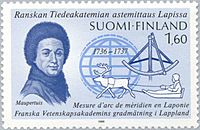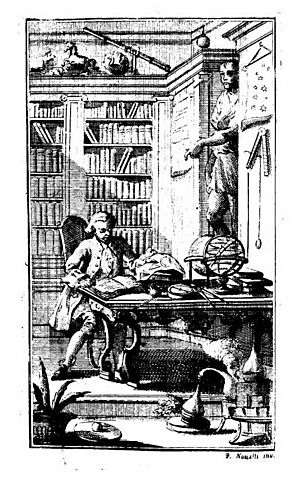Pierre Louis Maupertuis facts for kids
Quick facts for kids
Pierre Louis Maupertuis
|
|
|---|---|
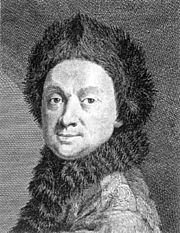
Maupertuis, wearing "lapmudes" from his Lapland expedition. With one hand he is pressing on the globe, making it oblate. Line engraving by J. Daullé, 1741, after R. Levrac-Tournières, 1737.
|
|
| Born | 1698 |
| Died | 27 July 1759 (aged 60) Basel, Switzerland
|
| Known for | Principle of least action, precursor of transmutation |
| Scientific career | |
| Fields | Mathematics, physics, biology, metaphysic, moral philosophy, astronomy, geography |
| Institutions | French Academy, Berlin Academy |
Pierre Louis Moreau de Maupertuis ( 1698 – 27 July 1759) was a French mathematician, philosopher and man of letters. He became the Director of the Académie des Sciences, and the first President of the Prussian Academy of Science, at the invitation of Frederick the Great.
Maupertuis made an expedition to Lapland to determine the shape of the Earth. He is often credited with having invented the principle of least action; a version is known as Maupertuis's principle – an integral equation that determines the path followed by a physical system. His work in natural history is interesting in relation to modern science, since he touched on aspects of heredity and the struggle for life.
Contents
Biography
Maupertuis was born at Saint-Malo, France, to a moderately wealthy family of merchant-corsairs. His father, Renė, had been involved in a number of enterprises that were central to the monarchy so that he thrived socially and politically. The son was educated in mathematics by a private tutor, Nicolas Guisnée, and upon completing his formal education his father secured him a largely honorific cavalry commission. After three years in the cavalry, during which time he became acquainted with fashionable social and mathematical circles, he moved to Paris and began building his reputation as a mathematician and literary wit. In 1723 he was admitted to the Académie des Sciences.
In the 1730s, the shape of the Earth became a flashpoint in the battle among rival systems of mechanics. Maupertuis, based on his exposition of Newton (with the help of his mentor Johan Bernoulli) predicted that the Earth should be oblate, while his rival Jacques Cassini measured it astronomically to be prolate. In 1736 Maupertuis acted as chief of the French Geodesic Mission sent by King Louis XV to Lapland to measure the length of a degree of arc of the meridian. His results, which he published in a book detailing his procedures, essentially settled the controversy in his favour. The book included an adventure narrative of the expedition, and an account of the Käymäjärvi Inscriptions in Sweden. On his return home he became a member of almost all the scientific societies of Europe.
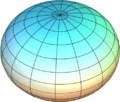 |
 |
| Maupertuis's opinion |
Cassini's opinion |
After the Lapland expedition, Maupertuis set about generalising his earlier mathematical work, proposing the principle of least action as a metaphysical principle that underlies all the laws of mechanics.
In 1740 Maupertuis went to Berlin at the invitation of Frederick II of Prussia, and took part in the Battle of Mollwitz on a donkey, where he was taken prisoner by the Austrians. On his release he returned to Berlin, and thence to Paris, where he was elected director of the Academy of Sciences in 1742, and in the following year was admitted into the Académie française. Returning to Berlin in 1744, again at the desire of Frederick II, he was chosen president of the Royal Prussian Academy of Sciences in 1746, which he controlled with the help of Leonhard Euler until his death. His position became extremely awkward with the outbreak of the Seven Years' War between his home country and his patron's, and his reputation suffered in both Paris and Berlin. Finding his health declining, he retired in 1757 to the south of France and went in 1758 to Basel, where he died a year later.
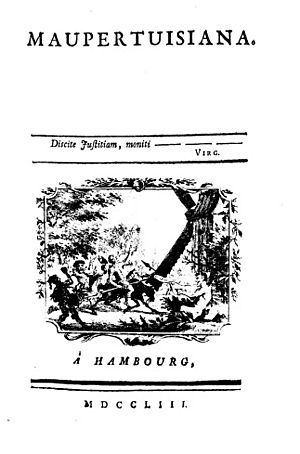
Main works
- La Figure de la Terre, déterminée par les Observations de Messieurs Maupertuis, Clairaut, Camus, Le Monnier & de M. l’Abbé Outhier, accompagnés de M. Celsius. (1738) link from Gallica
- Réflexions philosophiques sur l'origine des langues et la signification des mots, (1740), read online.
- Discours sur la parallaxe de la lune (1741)
- Discours sur la figure des astres (1742)
- Eléments de la géographie (1742)
- Lettre sur la comète de 1742 (1742)
- Astronomie nautique : ou Elémens d'astronomie , tant pour un observatoire fixe, que pour un observatoire mobile, (1743), link to Gallica
- Accord de différentes loix de la nature qui avoient jusqu'ici paru incompatibles (1744, English translation)
- Vénus physique (1745)
- Les loix du mouvement et du repos déduites d'un principe metaphysique (1746, English translation)
- Essai de philosophie morale (1749) link from Gallica.
- Essai de Cosmologie (1750).
Honours
- The crater Maupertuis on the Moon is named after him, as is the asteroid 3281 Maupertuis.
See also
 In Spanish: Pierre Louis Maupertuis para niños
In Spanish: Pierre Louis Maupertuis para niños


